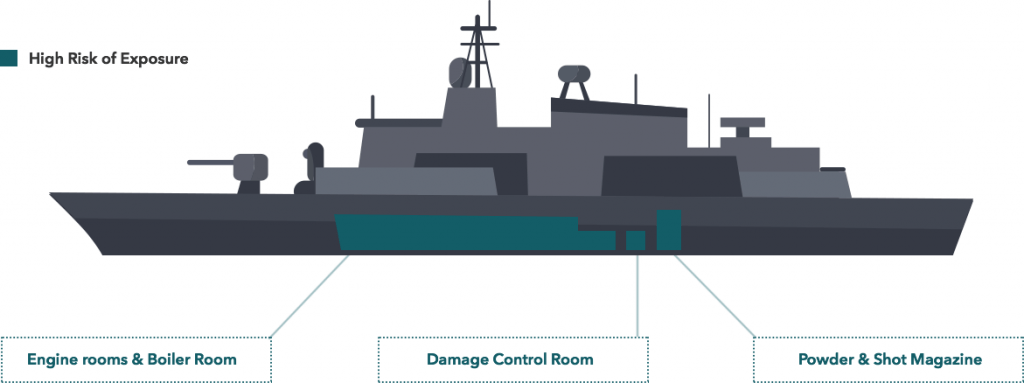When Did the U.S. Navy Use Asbestos on Ships?
The peak use of asbestos on navy ships was from the 1930s through the 1970s. All ships built during this period, both civilian and military, most likely contained asbestos.
The heaviest use of asbestos began in 1939 when the U.S. Navy started stockpiling it on the eve of World War II. The Navy stopped using asbestos in the early 1980s. It has since completed many abatement projects to protect current service members.
Why Did the U.S. Navy Use Asbestos on Ships?
Of all veterans in the military, members of the U.S. Navy were put at the greatest risk of exposure to asbestos and related illnesses. The Navy used asbestos in nearly every part of ships from World War II through the mid-1970s.[1]
There are several reasons why asbestos was considered so useful for ships:[2]
- Asbestos is an effective insulator
- It is lightweight
- Asbestos is also useful on ships because it resists fire
Fire onboard a ship, especially out at sea, is extremely dangerous. It is crucial to take all necessary steps to prevent fires, including using fire retardants like asbestos.[2]

How Did Asbestos on Ships Cause Exposure?
When asbestos materials are contained and encapsulated, they pose no risk. When exposed, the fibers can be released into the air where anyone in the area can inhale them.
Inhaled asbestos fibers lodge in tissues in the respiratory system. Over time, this causes damage and may result in illnesses like asbestosis, mesothelioma, or lung cancer.
Navy veterans may have inhaled asbestos fibers during ship construction and repair or when performing routine duties and maintenance on ships. For example, pipefitters could have cut through asbestos insulation releasing fibers into the air.
Where Were Asbestos-Containing Materials on Navy Ships?
Asbestos was used extensively throughout all types of Navy ships for about thirty to forty years. It could be found in nearly every part of the ship to insulate and prevent the spread of fire.
Sailors who worked below decks or in certain other parts of the ship were in especially close contact with the mineral. Some of the major uses of asbestos were in:[1]
- The Boiler Room: The boiler produces steam to power the ship and its machinery. It produces a huge amount of heat and requires insulation. Navy ships built before the 1970s included asbestos in the insulation around boilers and gaskets. Those workers in the boiler room were often exposed to asbestos while working with and servicing the boiler.
- Steam Pipes: The pipes carrying the steam and water throughout a ship also had to be insulated. They were wrapped in asbestos insulation. The pipes on these ships ran through every part of it, including where sailors ate and slept. Any damaged insulation could release particles of asbestos into the air and food.
- Valves and Pumps: Pumps and valves also contained asbestos insulation. Those workers who maintained and made repairs to pumps, valves, and associated gaskets were at risk of inhaling asbestos fibers.
- Fireproofing and safety gear. Asbestos textiles and paneling provided important fireproofing for Navy ships. Gunner’s mates wore asbestos gloves and sailors with safety and firefighting duties also used protective asbestos gear.
- Insulation. Nearly every type of insulation on navy ships was made from asbestos. This included boilers, pipes, walls, ceilings, pumps, and electrical systems.
In addition to these main uses for asbestos on Navy ships, the mineral could also be found in adhesives and flooring and fire-retardant material in paneling, bedding, deck covers, and other equipment and materials.
Which Navy Jobs Had the Highest Risk of Asbestos Exposure?
Asbestos was used so extensively that anyone on board could have been exposed. However, some specialties put sailors at greater risk than others:
- Boiler Workers. Boilers required a lot of insulation, often made with asbestos. Boiler workers also likely used protective gear that contained asbestos.
- Pipefitters. Pipefitters similarly worked around asbestos insulation. They were most likely to be exposed when replacing or repairing areas with pipe insulation.
- Engine Room Workers. Like boilers and pipes, engine room components produced heat and required asbestos insulation.
- Machinists. Machinists’ mates operated a lot of machinery, such as generators, pumps, and cooling systems, that contained asbestos insulation.
- Electricians. Electrical systems also contained asbestos insulation, putting electricians and electricians’ mates at risk.
- Shipyard Workers. Building and maintaining Navy ships in shipyards required handling a lot of asbestos materials, which put any of these workers at risk of exposure.
Navy Ships Affected by Asbestos
Some naval jobs put workers at greater risk than others, but all could and probably were exposed at some point. All kinds of ships in the Navy used asbestos, including:
- Aircraft carriers. The purpose of aircraft carriers is to go to sea to deploy and recover aircraft. They date back to 1900 in the U.S. Navy.
- Battleships. Battleships are designed to attack enemies, protect ships, and deter enemy ships.
- Destroyers. Destroyers are fast, maneuverable, and designed to escort larger ships and defend against enemy vessels.
- Amphibious ships. Amphibious vessels carry and discharge cargo, vehicles, and troops.
- Cruisers. Cruisers have played various roles in the Navy, including troop escort, merchant ship escort, and combat.
- Auxiliary ships. These ships provide numerous services to other ships, including bringing supplies and making repairs.
- Submarines. Designed to travel underwater, submarines are used for stealth operations and often carry nuclear missiles for deterrence purposes.
- Minesweepers. These are small vessels used to sweep the oceans for mines and to clear the way for other ships.
Merchant Marine Ships
The members of the U.S. Merchant Marine are not always remembered, but they, too, faced asbestos exposure. These civilians served in World War II by transporting cargo, troops, and military supplies using U.S. Maritime Service ships.[3]
Like the ships officially a part of the U.S. Navy, the ships these mariners worked on were full of asbestos. These civilians performed valuable and crucial services for the country during times of war.
According to one study of former merchant mariners, one-third of those examined had a pleural anomaly or abnormality that could lead to mesothelioma.
The study included over 3,000 former mariners and found that those who worked in the engine and boiler rooms of the ships were at particular risk of developing asbestos-related illnesses.[4]
Do Navy Ships Still Contain Asbestos?
The Navy stopped constructing ships with asbestos in the 1980s, but this was not the end of asbestos on ships. The Navy spent years removing or encapsulating existing asbestos on ships.
Much of it has been removed, but many old naval ships still have asbestos. These materials only pose a risk to current service members if they become damaged or exposed without the use of proper safety gear.
Are Current Navy Service Members at Risk of Asbestos Exposure?
Service members currently at risk are those involved in the maintenance, repair, or overhaul of older ships. The Navy is responsible for keeping these men and women safe by educating them about the risks of asbestos and providing safety training and gear.
U.S. Navy Veterans Have High Rates of Mesothelioma

Veterans, and Navy veterans, especially, have some of the highest rates of mesothelioma as compared to the general public.[5] Anyone working on ships during the period in which asbestos was used so extensively was at risk of being exposed.
Inhaled asbestos fibers can get lodged in the tissue around the lungs, called the pleura, and cause damage. Over decades, this can lead to the most common type of mesothelioma: pleural mesothelioma.[6]
Resources for Veterans of U.S. Navy Ships
Veterans who were unknowingly exposed to asbestos during service are now entitled to certain benefits.
VA Benefits
The U.S. Veterans Affairs Administration (VA) provides benefits to those veterans who can show that asbestos exposure during their service caused their illness.
Veterans may be eligible for:
- Monthly compensation
- Special compensation
- Health care
- Dependent benefits
The VA hospital in Los Angeles is a specialist center for mesothelioma where veterans with this disease can get cutting-edge care.[7]
If you or a loved one is a veteran and experienced asbestos exposure during service to the country, contact the VA to find out what benefits you may receive.
Legal Options
You may also be able to file a lawsuit against the manufacturer of asbestos-containing materials that you used on the job. Speak to an experienced mesothelioma lawyer to find out what your rights are.
Mesothelioma navy settlements can be anywhere from a few thousand to a few million dollars. The compensation amounts vary significantly by case.
If a company that supplied asbestos materials to Navy ships went bankrupt, they may have an asbestos trust fund. Many companies set up these trusts to compensate victims of exposure to their products. You can make a claim for compensation through one or more trusts.
What Should I Do if I Encountered Asbestos on a Navy Ship?
If you served in the U.S. Navy, you may have been exposed to asbestos. Talk to your doctor about screenings for asbestos illnesses. Monitor yourself for symptoms of mesothelioma and other respiratory conditions:
- Persistent coughing
- Wheezing and shortness of breath
- Chest pains
You should also contact a lawyer to find out what your options are for compensation. They can help you figure out where and when you were exposed, file a lawsuit on your behalf, make an asbestos trust fund claim, and help you navigate VA benefits.

Mary Ellen Ellis
WriterMary Ellen Ellis has been the head writer for Mesothelioma.net since 2016. With hundreds of mesothelioma and asbestos articles to her credit, she is one of the most experienced writers on these topics. Her degrees and background in science and education help her explain complicated medical topics for a wider audience. Mary Ellen takes pride in providing her readers with the critical information they need following a diagnosis of an asbestos-related illness.

Dave Foster
Page EditorDave has been a mesothelioma Patient Advocate for over 10 years. He consistently attends all major national and international mesothelioma meetings. In doing so, he is able to stay on top of the latest treatments, clinical trials, and research results. He also personally meets with mesothelioma patients and their families and connects them with the best medical specialists and legal representatives available.
References
- War Related Illness and Injury Study Center. (2013, August). Exposure to Asbestos.
Retrieved from: https://www.warrelatedillness.va.gov/education/factsheets/asbestos-exposure.pdf - Hedley-Whyte, J. & Milamed, D.R. (2008). Asbestos and Ship-Building: Fatal Consequences. Ulster Med. J., 77(3), 191-200.
Retrieved from: https://www.ncbi.nlm.nih.gov/pmc/articles/PMC2604477/ - U.S. Merchant Marine. (2014, September 29). Frequently Asked Questions about the Merchant Marine.
Retrieved from: http://www.usmm.org/faq.html - Selikoff, I.J., Lilis R. & Levin, G. (1990). Asbestotic Radiological Abnormalities Among United States Merchant Marine Seamen. Br. J. Ind. Med., 47(5), 292-7.
Retrieved from: https://www.ncbi.nlm.nih.gov/pmc/articles/PMC1035162/?pageindex=1&tool=pmcentrez - U.S. Department of Veterans Affairs. (n.d.). Hope for Veterans with Asbestos-Related Cancer.
Retrieved from: https://www.blogs.va.gov/VAntage/14948/hope-for-veterans-with-asbestos-related-cancer/ - National Cancer Institute. (2017, June 7). Asbestos Exposure and Cancer Risk.
Retrieved from: https://www.cancer.gov/about-cancer/causes-prevention/risk/substances/asbestos/asbestos-fact-sheet - U.S Department of Veterans Affairs. (2015, June 9). VA Greater Los Angeles Healthcare System.
Retrieved from: https://www.losangeles.va.gov/services/Mesothelioma.asp


